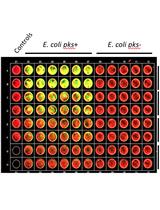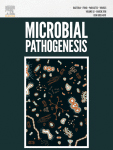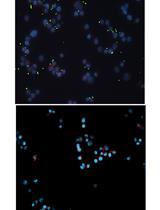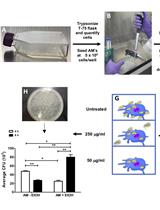- EN - English
- CN - 中文
Adhesion and Invasion Assay Procedure Using Caco-2 Cells for Listeria monocytogenes
单核细胞增生李斯特菌对Caco-2细胞的粘附和侵袭试验程序
发布: 2017年05月05日第7卷第9期 DOI: 10.21769/BioProtoc.2267 浏览次数: 16273
评审: Valentine V TrotterSofiane El-Kirat-ChatelAlexander B. Westbye

相关实验方案

γ-H2AX作为标志物采用细胞内蛋白质印迹法(ICW)定量HeLa细胞中Colibactin相关基因毒性
Sophie Tronnet and Eric Oswald
2018年03月20日 7993 阅读
Abstract
Listeria monocytogenes is an important Gram-positive foodborne pathogen that is a particular problem in ready-to-eat food. It has an ability to survive in harsh conditions like refrigeration temperatures and high salt concentrations and is known to cross intestinal, placental and blood-brain barriers. Several cancerous cell lines like cervical, liver, dendritic, intestinal and macrophages have been used to study in vitro propagation and survival of listeria in human cells. Human intestinal epithelial cells have been used to study how listeria crosses the intestinal barrier and cause infection. The protocol in this articles describes the procedures to grow Caco-2 cells, maintain cells and use them for adhesion and invasion assays. During adhesion assay the cells are incubated with listeria for 30 min but in invasion assay the cell growth is arrested at several time points after infection to monitor the growth and survival rate of listeria in cells.
Keywords: Adhesion assay (粘附试验)Background
Listeria monocytogenes being a facultative intracellular bacterium can enter, survive and multiply in both phagocytic and non-phagocytic cells and this property of the bacterium has been extensively studied and understood. Being a foodborne pathogen it enters the blood stream in humans via intestines by crossing intestinal barriers. Thus human intestinal cells are used as an in vitro medium to study adhesion and intracellular survival of Listeria monocytogenes. Human colon adenocarcinoma cells, Caco-2 cells have been used extensively as a model for intestinal barrier (Angelis and Turco, 2011).The protocol described in this article explains the procedure to grow and maintain Caco-2 cells and then infect them to study adhesion and invasion properties of listerial species. This protocol can also be used with minor changes for cells like HT-29 (human colorectal adenocarcinoma cells) and Tc7 cells (a subclone of the Caco-2 cell line have) which have also been used to study Listeria. These assays are generally used to compare the pathogenicity of listerial mutants with wide type(WT) strains (Reddy and Lawrence, 2014). Adhesion assay is straight forward wherein the bacteria are incubated with Caco-2 cells for 30 min and the bacterial counts for mutants and WT strains are compared to observe any alteration in adhesion properties as a result of mutation. Bacterial counts obtained at different time points during invasion assay give more information about the survival of listeria in the human cells and the comparison of these counts between mutants and WT strains gives information about the changes in the adaptation of listeria after mutation in human cells. This protocol has been successfully used previously to study the adhesion and invasion properties of listerial strains (Jaradat and Bhunia, 2003; Lecuit, 2005; Sambuy et al., 2005; Reddy et al., 2016).
Materials and Reagents
- MF-Millipore filters (EMD Millipore, catalog number: SCGPU05RE )
- Eppendorf tubes (Eppendorf, catalog number: 022363204 )
- Cell culture flasks (Corning, catalog number: 3275 )
- Cell culture plates (12-well cell culture receiver plate, sterile) (EMD Millipore, catalog number: PIMWS1250 )
- Pipette tip
- 15 ml culture tube
- Cell scrapers (Corning, catalog number: 3010 )
- ZapCap bottle-top filters, pore size 0.2 µm (Maine Manufacturing, catalog number: 10443421 )
- Serological pipettes (1, 5, 10, 25, 50 ml) (Corning, catalog numbers: 4010 , 4050 , 4100 , 4250 , 4501 )
- Culture tubes (Sigma-Aldrich, catalog number: T1661 )
- Listeria monocytogenes strains F2365 (wild type strain), and F2365∆2117(mutant strain) (Reddy et al., 2016)
- Caco-2 cell line (ATCC, catalog number: HTB-37 )
- 70% ethanol (Fisher Scientific, catalog number: BP82014 )
- Trypsin-EDTA solution (Sigma-Aldrich, catalog number: T3924 )
- Brain Heart Infusion (BHI) agar (Sigma-Aldrich, catalog number: 70138 )
- BHI broth (Sigma-Aldrich, catalog number: 53286 )
- Gentamicin (Sigma-Aldrich, catalog number: G1397 )
- Eagle’s minimum Essential medium (EMEM) (ATCC, catalog number: 30-2003 )
- Fetal bovine serum, certified, heat inactivated (FBS) (Thermo Fisher Scientific, GibcoTM, catalog number: 10082147 )
- Penicillin-streptomycin (10,000 U/ml) (Thermo Fisher Scientific, GibcoTM, catalog number: 15140122 )
- Dulbecco’s phosphate buffered saline (Sigma-Aldrich, catalog number: D8537 )
- Triton X-100 (Sigma-Aldrich, catalog number: 234729 )
Note: This product has been discontinued. - Phosphate-buffered saline, 10x (PBS) (Sigma-Aldrich, catalog number: P5493 )
- cEMEM (see Recipes)
- 0.1% Triton-X 100 (see Recipes)
- 1x PBS (see Recipes)
Equipment
- Water bath, 37 °C (Thermo Fisher Scientific)
- CO2 forced-air incubator (Thermo Fisher Scientific, Thermo ScientificTM, model: FormaTM Steri-CultTM CO2 Incubators , catalog number: 3307TS)
- Biological safety cabinet (Thermo Fisher Scientific, Thermo ScientificTM, model: 1300 Series Class II )
- Inverted microscope(Nikon Instruments, model: Eclipse Ti-S )
- Pipette (Thermo Fisher Scientific, Thermo ScientificTM, catalog number: 4642070 )
- Pipettor (Daigger Scientific, model: Portable Pipet-Aid XP Pipette Controller )
- Hemacytometer (Fisher Scientific, catalog number: S17040 )
- 37 °C incubator (Thermo Fisher Scientific)
- 37°C shaker (Thermo Fisher Scientific)
- Microcentrifuge, 4 °C (Eppendorf)
- Fisher Scientific Sonic dismembrator (Fisher Scientific, model: 100 )
- Vortex (Thermo Fisher Scientific, Thermo ScientificTM, model: LP Vortex Mixer , catalog number: 88880018)
Procedure
文章信息
版权信息
© 2017 The Authors; exclusive licensee Bio-protocol LLC.
如何引用
Reddy, S. and Austin, F. (2017). Adhesion and Invasion Assay Procedure Using Caco-2 Cells for Listeria monocytogenes. Bio-protocol 7(9): e2267. DOI: 10.21769/BioProtoc.2267.
分类
微生物学 > 微生物-宿主相互作用 > 体外实验模型 > 细胞系
微生物学 > 微生物-宿主相互作用 > 细菌
细胞生物学 > 基于细胞的分析方法 > 细胞粘附
您对这篇实验方法有问题吗?
在此处发布您的问题,我们将邀请本文作者来回答。同时,我们会将您的问题发布到Bio-protocol Exchange,以便寻求社区成员的帮助。
Share
Bluesky
X
Copy link











